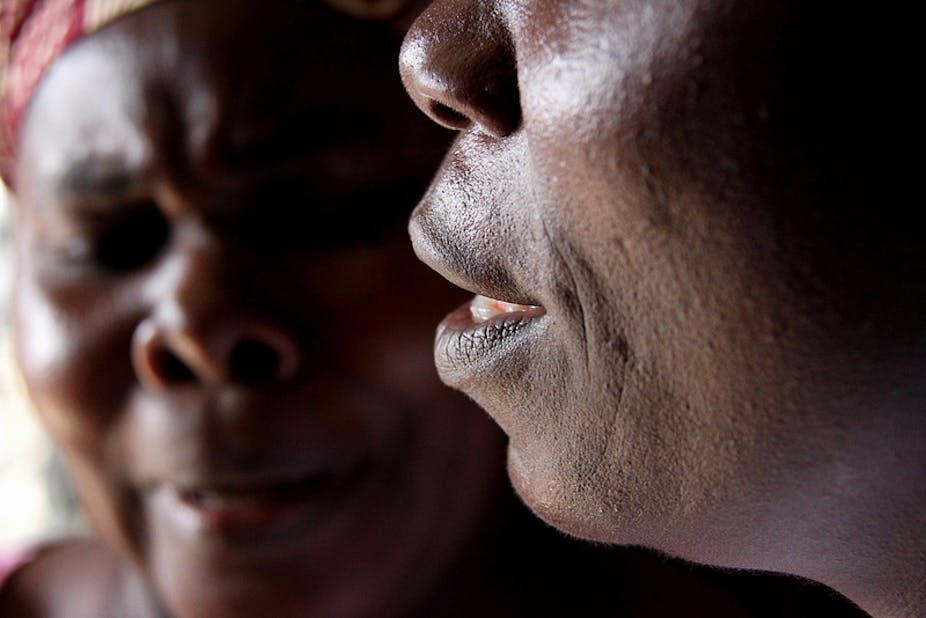Female genital cutting (FGC) – also known as female genital mutilation (FGM) or female circumcision – is widely practised in Africa and has been described by UNICEF “one of the worst violations of the Convention on the Rights of the Child”. And rightly so. It is usually performed on girls between the ages of four and eight, or as late as their first menstrual cycle.
It’s increasingly relevant to Australia because of the growth in migration of people from communities that practise FGC. In 2010, Melbourne’s Royal Women’s Hospital reported seeing as many as 700 women who had suffered some form of FGC.
There are three types of FGC, which range in severity from a clitoridectomy or removal of the clitoris (type 1); clitoridectomy and the additional removal of the labia minora (type 2); to pharaonic circumcision or full infibulation, which removes part of the labia majora too (type 3). Infibulation leaves nothing of the normal genitalia except for a wall of flesh from the pubis to the anus, except a pencil-size opening of the vulva to allow urine and menstrual blood to pass through.

In the latter case, the adult woman will often suffer reverse infibulation to allow for sexual intercourse; this may be performed by the husband using a knife on their wedding night.
During childbirth, the enlargement is too small to allow vaginal delivery and so the infibulation must be opened completely by enlarging the vagina with deep episiotomies (surgical cuts). Afterwards, the mother will often insist that what is left of her vulva be closed again so that her husband does not reject her, nor her friends and family ostracise her.
FGC is illegal in many Western countries, including Australia, and often regarded as sadistic mutilation of girls and women. So what explains the practice?
For behaviour to be condemned it must be perceived as in some way harmful to an individual or their community. That is not the case in communities that practice FGC. Evidence from Egyptian mummies shows both clitoridectomy and infibulation occurred in Pharaonic times. Although it is sometimes claimed that the practice was spread from Egypt by Arab traders, there is no evidence for this. FGC transcends both culture and religion.
It seems likely that one motive for FGC is to decrease the risk of female promiscuity, since it reduces and may remove the woman’s sexual pleasure. This ill-effect, however, is firmly disputed by some infibulated women who do undoubtedly enjoy orgasm. Nevertheless, FGC is most likely to have negative effects on the woman’s sexual pleasure.
Infibulation supposedly provides a proof of virginity, which is a necessary condition for marriage in many FGC-promoting societies. This creates an economic advantage by permitting parents to demand a high bridal price. In some societies, men are forbidden to marry uncircumcised women.
One other reason given for FGC is that removal of secreting parts of the genitalia maintains cleanliness. This is unquestionably spurious because FGC cannot prevent urination, menstruation, nor vaginal secretions resulting from sexual arousal.
FGC is sometimes claimed to cure depression, hysteria, and insanity. This is certainly pure myth. It is reported that the Mossi of Burkina Faso and the Igbo of Nigeria believe that babies will die if they touch the clitoris during birth; once again, this is incorrect.
More believably, it is sometimes claimed that FGC enhances beauty and that FGC prolongs the sexual pleasure of men. Of course, the same can be said of those Western women who insert rings through their clitoris and labia: an acceptable form of genital mutilation in our society.

FGC is inflicted on about between two and three million girls a year, mostly by people who have had no medical training, who perform the cutting without anaesthetic, sterilisation, or the use of proper medical instruments.
Most girls do survive, but the procedure can lead to death through shock from immense pain, excessive bleeding, or infection. There is often scarring or obstructed flow of urine and menstrual blood, which leads to urinary- and reproductive-tract infections and infertility.
According to the World Health Organization, all types of FGC pose an increased risk of death to the baby. Between 10 and 20 of every 1,000 babies born in Africa die during delivery as a result of the mothers having undergone genital cutting. Infibulated women are also 30% more at risk for caesarean sections and 70% more likely to hemorrhage after childbirth compared with women without FGC.
So how do we put an end to this practice?
FGC, like male circumcision, is committed almost exclusively on children, and it is the preferences of the child’s parents which dominate. Those preferences reflect the values of the society in which they live; parents need for their daughter to be socially acceptable.
To be proscribed in FGC-practising communities, female genital cutting has to be accepted as an injurious practice. Mothers would have to accept that they themselves had been harmed by their own parents; next, they would need to persuade their menfolk that FGC should be tabooed. Unfortunately it’s unlikely to happen any day soon.
In June this year, a court in Cologne, Germany, ruled that male circumcision was a form of grievous bodily harm that violated the “fundamental right of the child to bodily integrity”. There was outrage from Jewish and Islamic groups on grounds that the ruling contravenes the rights of certain cultural communities.
The same objection and defence applies to FGC.

